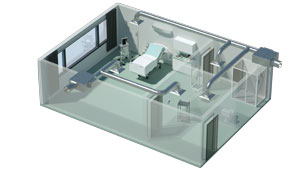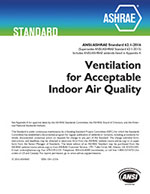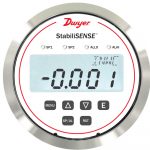
The purpose of a healthcare isolation room is to prevent patients with contagious illnesses from spreading to others or to keep immunocompromised patients safe from exposure to airborne pathogens. As such, there exist two types of isolation rooms, either positively or negatively pressurized.
Positive pressure isolation rooms are designed to keep pathogens and outside air from entering the room, i.e. air inside the room is forced outward and is typically used for immunocompromised patients. Like clean rooms, it is important to maintain proper positive pressure within the protective isolation room to keep the patients safe.
On the other hand, negative pressure isolation rooms are designed to keep pathogens and air from exiting the room. In other words, air from the outside is forced into the room.
Negative pressure isolation rooms or airborne infection isolation rooms (AIIRs) are used with patients with contagious illnesses, such as COVID-19, to prevent airborne viruses, bacteria, etc. from spreading to other areas in the healthcare facility.
Why Pressure Differential is Important in Isolation Rooms

A pressure differential between the AIIR and the anteroom (room just outside the isolation room) is needed to prevent unwanted airborne pathogens from escaping into the adjacent rooms and hallways.
When an isolation room is kept at a negative pressure in relation to the anteroom, air from the anteroom will be pulled into the isolation room. This negative pressure relation will prevent pathogens from escaping as no air can leave the isolation room.
Industry Guidelines and Recommendations
In their Health Care Facilities Ventilation Controls and Guidelines for Management of Patients with Suspected or Confirmed SArRS-CoV-2 (COVID-19) document, the American Society of Healthcare Engineers (ASHE), recommends practices for airborne infection isolation rooms (AIIRs).
In their recommendations, ASHE states that AIIRs must be under negative pressure and meet 6-12 air changes per hour depending on the building design and room criteria. Additionally, the isolation rooms should exhaust through a HEPA filter if recirculated or to unoccupied areas outside of the healthcare facility.
 The ASHRAE 62.1 Standard for Ventilation for Acceptable Indoor Air Quality provides guidelines for minimum ventilation rates and other parameters (such as CO2) to ensure indoor air quality (IAQ) is kept at safe levels. Routine ventilation and safe IAQ levels help prevent adverse health effects caused by air quality factors. Proper ventilation and IAQ are key for maintaining the safety of isolation rooms. Along with 62.1, ASHRAE also provides ventilation standards for healthcare facilities.
The ASHRAE 62.1 Standard for Ventilation for Acceptable Indoor Air Quality provides guidelines for minimum ventilation rates and other parameters (such as CO2) to ensure indoor air quality (IAQ) is kept at safe levels. Routine ventilation and safe IAQ levels help prevent adverse health effects caused by air quality factors. Proper ventilation and IAQ are key for maintaining the safety of isolation rooms. Along with 62.1, ASHRAE also provides ventilation standards for healthcare facilities.
Several devices are used to ensure that airborne infectious isolation rooms meet CDC design requirements as well as ASHRAE’s Standard 170, Ventilation of Health Care Facilities. The CDC design requirement for airborne infection isolation rooms (AII or AIIR) requires:
- Use of negative pressure rooms with close monitoring of airflow direction using manometers or temporary or installed visual indicators placed in the room with the door closed
- Negative pressure room engineering features include negative pressure
- Pressure differential of 2.5 Pa (0.01 inches of water column)
- Minimum of 6 ACH (Air Changes per Hour) for existing facilities, greater than or equal to 12 ACH for areas under renovation or for new construction
- Air from negative pressure rooms and treatment rooms exhausted directly to the outside if possible
These design requirements can be met by the use of peripheral sensors measuring pressure, airflow, or humidity mounted in and around the airborne infectious isolation room. These devices provide measurements of current conditions and provide a linear signal back to a building management system (BMS). The software in the BMS maintains room design requirements by demanding additional airflow from the building’s HVAC equipment as needed.
How are Sensors Tied into Isolation Rooms (AIIRs)?
Negative pressure in AIIRs and isolation rooms is maintained by a fan, or blower, which could be within a VAV (variable air volume) system and an exhaust fan that varies the amount of air provided and removed from the isolation room. The more air removed from the room, the lower the air pressure in it.

A differential pressure sensor like a Magnehelic® gage can be used to visually verify the negative pressure. However, to provide feedback to a control system or DDC (direct digital controller), pressure transmitter devices like room pressure monitors, room status monitors, or simple differential pressure transmitters should be used to measure the pressure difference between the isolation room and anteroom.
After receiving the signal from the pressure transmitter, the DDC controls the VAV system. If the pressure is too low, the VAV system will provide more air; if the pressure is too high, the VAV system will limit the amount of air it pumps into the room or exhaust more air through the exhaust system.
Since the pressure that is to be maintained is relatively narrow (as low as 0.01” w.c.), it is important that the differential pressure sensors maintain their accuracy over time. Additionally, it is equally important for air velocity and air flow transmitters to provide high, consistent accuracy over time to maintain proper air changes (6-12 ACH) in the isolation rooms.
In other words, the sensors need to have excellent stability to help with conformance to ASHRAE 62.1 guidelines, ASHRAE Standard 170, and ASHE’s guidelines for health care facilities.
If stability is not maintained and the pressure, air velocity, or air quality sensors drift (thus becoming inaccurate over time), the VAV and exhaust system will either provide too much or too little air. As a result, the negative pressure of the isolation can be compromised. Pathogens can then exit the AIIR and potentially spread to staff and visitors outside of the isolation room.
To learn more about stability and why it is important, read our previous blog articles listed below:
